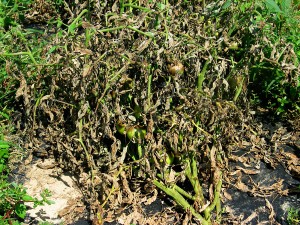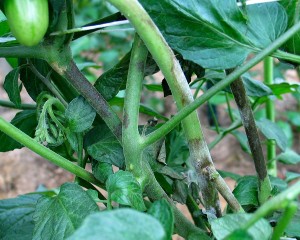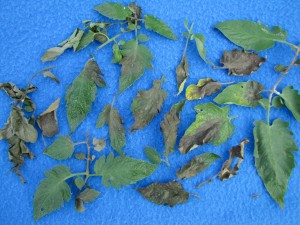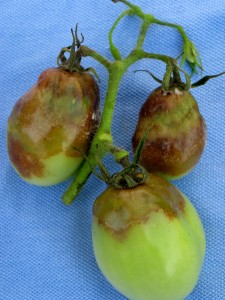Late Blight in Tomatoes and Potatoes
Late Blight in Tomatoes and Potatoes
Late Blight is a serious disease of potatoes and tomatoes worldwide, with a tremendous human and economic cost. It was the arrival of late blight in Ireland in the 1840’s that resulted in the Irish Potato Famine that caused 1 million deaths and another million people to emigrate from Ireland, many to the United States. Luckily, Idaho is somewhat protected from the devastation of Late Blight. Our dry climate with low humidity, hot days, and cool nights does not meet Late Blight’s requirements of high humidity or wet conditions. That’s one of the reason’s Idaho became the potato capital of the world. According to the University of Idaho, prior to 1995 only one isolated case of late blight had been reported in the state. That all changed in 1995 when severe crop losses occurred in many fields in western Idaho and even a few in eastern Idaho. Since then, the disease has periodically shown up in commercial potato production areas across the state, but it is still fairly rare in east Idaho. However, with the abnormally wet August this year it has reared its ugly head again.
Late blight is caused by Phytophthora infestans, a disease organism that mainly affects potatoes and tomatoes. Spores produced on infected plants can travel through the air, land on infected plants, and if the weather is sufficiently wet, cause new infections. Infection occurs during wet or humid conditions at temperatures of 60-70°F. The pathogen survives from one season to the next primarily in infected potato tubers.
Late Blight Symptoms
Infected potatoes have shallow, brownish or purplish lesions on the surface of the tuber. On potato plants black lesions can occur on both leaves and stems. Black lesions appear within 3-7 days of infection of leaves. On stems, late blight causes brown, greasy looking lesions that frequently appear first at the junction between the stem and leaf, or at the cluster of leaves at the top of the stem.
Symptoms on tomato leaves and stems are similar to those on potato. On tomato fruit, late blight causes a firm, dark, greasy looking lesion. If the symptoms include brown spots on leaves with concentric rings and a yellow halo it is likely Early Blight, not Late Blight. For diagnosis, bring the sample to Town & Country Gardens in a sealed plastic bag.
See many more photos to help diagnose Late Blight in tomatoes at the Cornell University site here.
The experts at Cornell University warn,
“Because late blight produces so many spores, and the spores can travel long distances through the air, it is very important that everyone who grows potatoes or tomatoes is able to identify late blight and know how to control it, to avoid being a source of spores that infect potatoes and tomatoes in neighboring gardens and commercial fields. This disease is capable of wiping out not only your entire potato and tomato crop but also commercial fields very quickly under wet conditions, and farmers who grow potatoes or tomatoes are at serious risk of losing their entire income from these crops.”
Since there are currently no labeled chemicals that will cure the disease once it becomes established in a plant, it is extremely important that proper practices be employed in the home garden as well as the commercial farm to prevent the disease from becoming established.
Here are some “best practices” that all home gardeners should follow:
1- Plant only certified disease free potato seed, and healthy tomato plants.
2- Monitor your garden frequently, scouting for signs of disease.
3- Immediately remove any infected vines and fruit and burn them or throw in garbage.
4- Don’t put potato or tomato vines, tubers or fruit in your compost pile.
5- Avoid overhead irrigation if possible.
6- Chorothalonil or organic copper sprays can help prevent (not cure) the disease.
7- Remove all tomato and potato vines from the garden in the fall to the garbage.
Thankfully, Late Blight is a rarity in east Idaho. But with this year’s wet August it is showing up. Do your part to halt its spread by following these best practices to keep your garden clean, as well as your neighbors and the local farmers.






